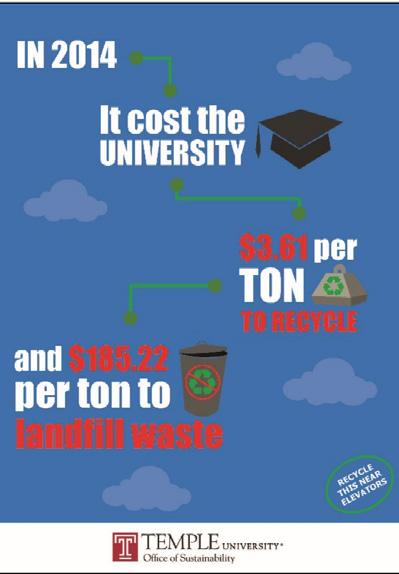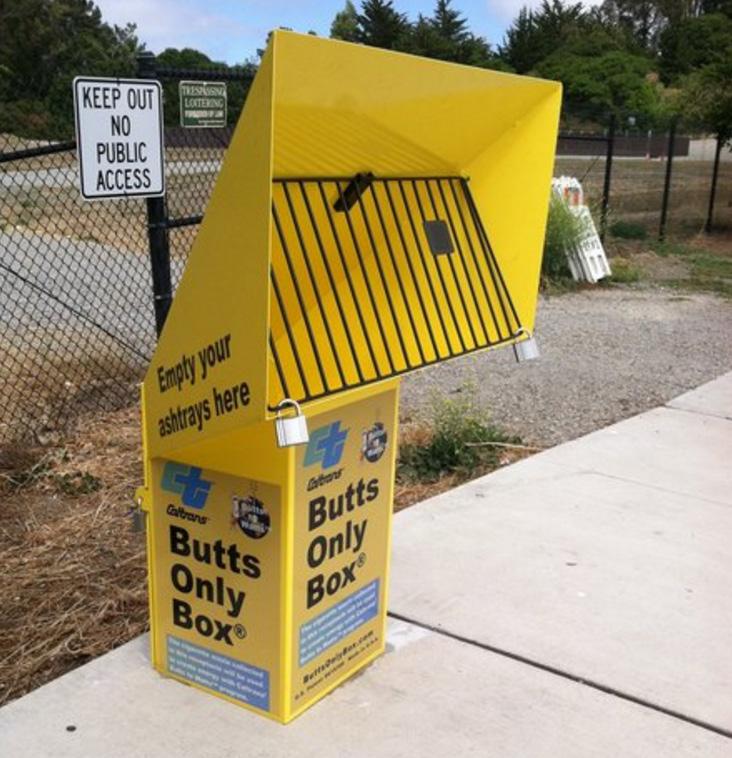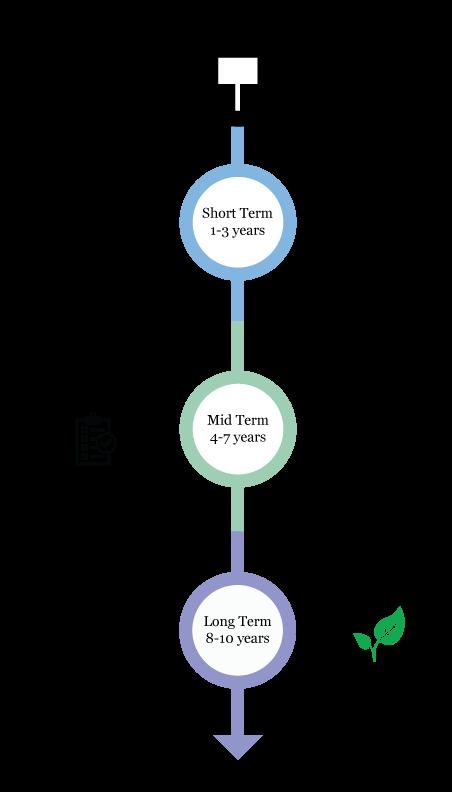
4 minute read
Install Signage To Encourage Environmental Conscientious Behavior
“Signage used at Temple University dormitories to encourage recycling”
APA CITATION: Porter, D. (other). (2015). Phase two signage. Philadelphia,
Pennsylvania; Temple University. ] 151 Signage Used at Temple University Dormitories to Encourage Recycling.
CASE STUDY: Temple University
In 2015, Temple University conducted a study to see if signage had any measurable impact on recycling rates in residential dorms. The research conducted showed that signage “had a profound impact on the success rate of the recycling program” (Porter, 2015). Signage that is unclear or non-existent was one of the biggest complaints voiced by participants. Additionally, an increase of the existing signage on bins seemed to have a positive correlation with recycling rates. The report also suggests that signage can supplement “a larger educational system” to “influence a positive behavior change toward recycling practices” (Porter, 2015). Labor TBD* per collector (*requires negotiation between IAG and the Association)
TBD by Instituto Anchieta Grajaú and Movimento Anchieta
INSTALL SIGNAGE TO ENCOURAGE ENVIRONMENTAL CONSCIENTIOUS BEHAVIOR
The Occupation should install a combination of signage and modeling to help form a new social norm related to littering. Currently, there is limited signage, with almost no signage related to environmental and behavioral concerns. According to an observational study, “signs can provide viewers with practical information, persuasive information, and behavioral cues for decision making” (Sussman et al., 2011, p. 325). The goal of using signage in the Occupation is to discourage behavior that negatively impacts the environment, such as dumping in community spaces, smoking, and burning/burying litter, and to ultimately encourage positive behavior, such as using trash receptacles and composting.
Signage will have to be strategically located and designed with the following elements in mind (Sussman et al., 2011): - the target behavior is relatively convenient to engage in - the behavior is specified in precise terms - convenient alternative desirable behaviors are suggested when an undesired behavior is targeted (e.g., disposing of bottles in a recycling bin rather than the garbage) - the message is delivered in close proximity to opportunities for engaging in the target behavior

CASE STUDY: Oceanside, CA
Oceanside, CA, is located downstream of two watersheds, where pollution accumulates on publicly accessible beaches, namely, cigarette butts. A local resident designed the “Butts Only Box(R)” to be installed in high foot-traffic areas. After installation, 170 pounds of cigarette butts were properly disposed of in the first four years of the program. The study shows that there are ways to improve proper cigarette disposal, with a 5.5% increase at sites with ash receptacles installed. The research also shows that clearly visible signage helps to reduce cigarette littering (Beckstead, 2014).
152 A Butts Only Box at the Entrance of a Park.
- the message is stated in polite language that does not threaten an individual’s perceived freedom
Signage should also be simple and symbology-based. A number of residents in the Occupation are not literate and will only be influenced by signs that can communicate with minimal word usage. Signs do not have to be very detailed to influence behavior; “traffic sign and computer lab studies also suggest that noticeability, simplicity, and clarity are important aspects of sign design” (Sussman et al., 2011, p. 325).
A combination of signage and behavioral modeling would be most effective in developing a new behavioral norm. Studies suggest that “observing modeled behavior is associated with that behavior being more likely to be performed” (Sussman et al., 2011, p. 338). One way to implement behavioral modeling is to designate community leaders, such as those in charge of the Association, as confederates, or models of a desired behavior. After appropriate signage is installed, these confederates can demonstrate the new behavior so that the behavior is more likely to develop as a norm.
For example, with the installation of trash receptacles and signage communicating not to litter, confederates from the community can openly demonstrate the behavior of regularly disposing of trash in the appropriate receptacles. This behavioral demonstration could be applied

153 Signage Timeline. to a myriad of activities, such as smoking prohibition, recycling, or even composting.
The Association could regularly maintain the designated sites in terms of cleanliness and presence of litter, even after signage installation and the development of a new social norm. “Individuals use a variety of cues from their surrounding environment to determine what common and accepted behavior is. The presence of litter communicates the norm for that situation…” (Schultz et al., 2011, p. 54). Thus, a cleanup of the sites should occur regularly to discourage unsustainable behavior. Additionally, Community Clean up Days or Earth Day Celebrations may be an important educational opportunity. This will be discussed later in the chapter.
The Association can encourage residents to quit smoking habits as a way to reduce environmental impact. Litter poses a number of important environmental, social, and aesthetic problems (Schultz et al., 2011), and cigarette butts are consistently the most collected items in litter clean-up efforts (Rath, 2012). In addition to environmental reasons, reducing the prevalence of smoking will provide numerous benefits to Occupation residents in terms of health and financial needs.
Cigarette butts make up a majority of litter because all smokers enter a vicinity with something to litter — a cigarette. One study shows that the littering rate (for non-smokers) was 17%, but for smokers the littering rate was 65% (Schultz et al., 2011, p. 50). The Association coordinators can discourage the act of smoking in a number of ways, including signage, modeling, and education.
In terms of signage, anti-smoking symbology on signage located in the most vulnerable






